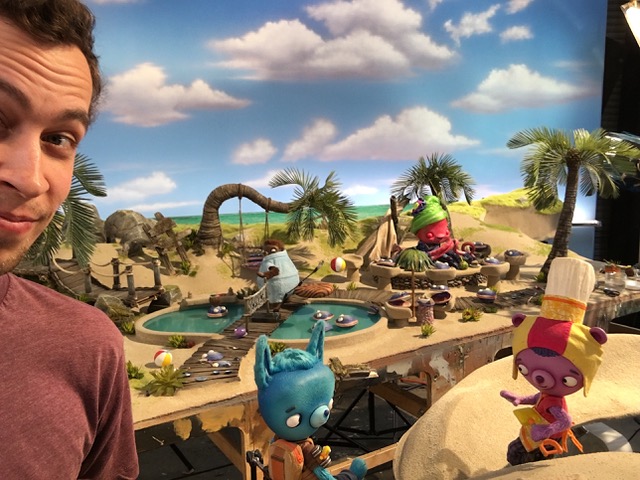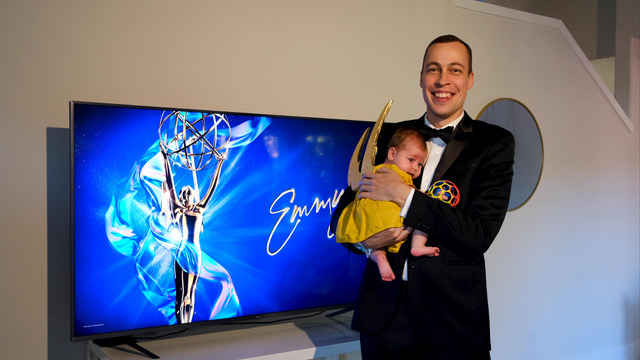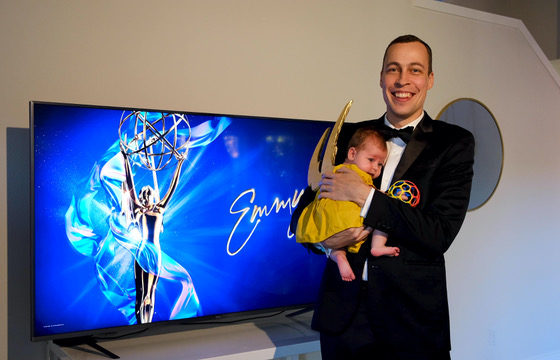It has been a big couple of months for Dan Mackenzie (GHS ’07) who recently was presented with not one, but two Creative Arts Emmy Awards.
The first was in June, as supervising animator for work on the Amazon original series “Tumble Leaf”, a well-regarded series for preschoolers. The second was for outstanding individual achievement for his work on the documentary “Cosmos: Possible Worlds” episode four. “Cosmos”, hosted by Neil deGrasse Tyson, premiered on FOX in September. MacKenzie’s episode aired on October 13.
Interestingly, MacKenzie’s Gorham friend, Eben McCue (GHS ’08), also recently won an Emmy for Motion Design.
MacKenzie is fulfilling a childhood dream working as a stop motion animator at Laika Studio in Portland, Oregon. Laika’s hit movies include three on which MacKenzie worked: “ParaNorman,” “BoxTrolls,” “Kubo,” as well as “Coraline” and “Missing Link,” the 2020 Golden Globe Award winner for best animated feature. Laika is known for setting high creative and technical standards and for making entertainment that has something important and meaningful to say.
As a stop motion animator, MacKenzie is the physical actor who moves the puppets one frame at a time to the sounds of the pre-recorded voice actor’s performance. “Animators get cast on a shot or scene, and they pose and animate everything moving on screen, one frame at a time, 24 frames per second for features, and 12 frames per second for TV shows. I often create only a few seconds of footage per day,” he said.

MacKenzie explained that much of the animation we see is made using computer generated (CG) images while the stop motion technique creates the illusion of movement by using real objects which are physically moved in very small increments between photographed frames.
When asked about the difference in the two techniques, MacKenzie said, “Stop motion is much more physical and tactile, which I like, but you’re constantly fighting gravity, needing rigs and supports to keep the puppets from falling to the ground. Leaning over miniature sets all day can also be hard on your body. CG can be done while seated at a computer where you can easily make as many adjustments to the animation as needed. In stop motion, once you animate a shot… that is it. You either keep it or reshoot it.”
In the world of animated films, individual departments are responsible for each aspect of making a feature film. In stop motion, the puppets, mostly constructed with a metal skeleton covered with silicone flesh and miniature cloth clothes, are made in one department. Sets are designed and constructed in another department, the lighting and camera team is its own entity, script writing and editing are also separate. MacKenzie said, “For my own short films, I found myself doing everything, but professionally, I am hired just for adding life through movement.”

Dan MacKenzie and daughter Eleanor celebrate as he receives a second Creative Arts Emmy Award for his outstanding work on the FOX science documentary series “Cosmos: Possible Worlds,” hosted by Neil deGrasse Tyson.
Mackenzie’s interest in film started early when he and his brother, John, began to make movies with the neighborhood kids. He began to focus on animation in high school when he became enamored with the technique of claymation. “My parents bought me a computer and let me set up a workstation in my dad’s home office where I would animate into the early hours of the morning,” he said. He and his mother travelled to film festivals in Chicago, Atlanta, and Austin, where his short films were screened. “My parents were amazingly supportive. I really never had any pushback for pursuing this dream, as I think they saw it was more than just a hobby for me,” he added.
At the GHS talent show, as a sophomore, he wheeled out a projector and played “Become”, one of his first full animations of a wire man creating himself. He said, “The audience reaction sealed the deal for me that this was the career path I wanted to take.” MacKenzie said his mentor at GHS, Rob Roy, offered great guidance, support, and help with some technical aspects of the craft. His advice for students interested in animation is to work at it first as a hobby, to see if you have a real passion for it, before pursuing an expensive degree.
MacKenzie attended Savannah College of Art and Design (SCAD) and received BFA in Animation in 2011. He received a general arts education, with the last two years fully focused on animation. The summer before his senior year, he landed an internship on “Robot Chicken,” an irreverent, adult comedy series. He said, “I learned so much in those two months in a true studio environment, I primarily went back to SCAD just to make a senior film, as I knew that was going to be my last chance to really focus on my own work. Animators are often hired on a project basis, so after graduation he headed to the West Coast and bounced between studios in Oregon and Los Angeles, before being hired on staff by Laika in 2019.
MacKenzie lives in Portland, Oregon, with his wife Allison, two cats, and three-month-old daughter Eleanor. He is the son of Chris and Deb MacKenzie. His brother is John MacKenzie (GHS ’05).
MacKenzie can be reached through www.mackmation.com and his Instagram handle is @Mackmation.


